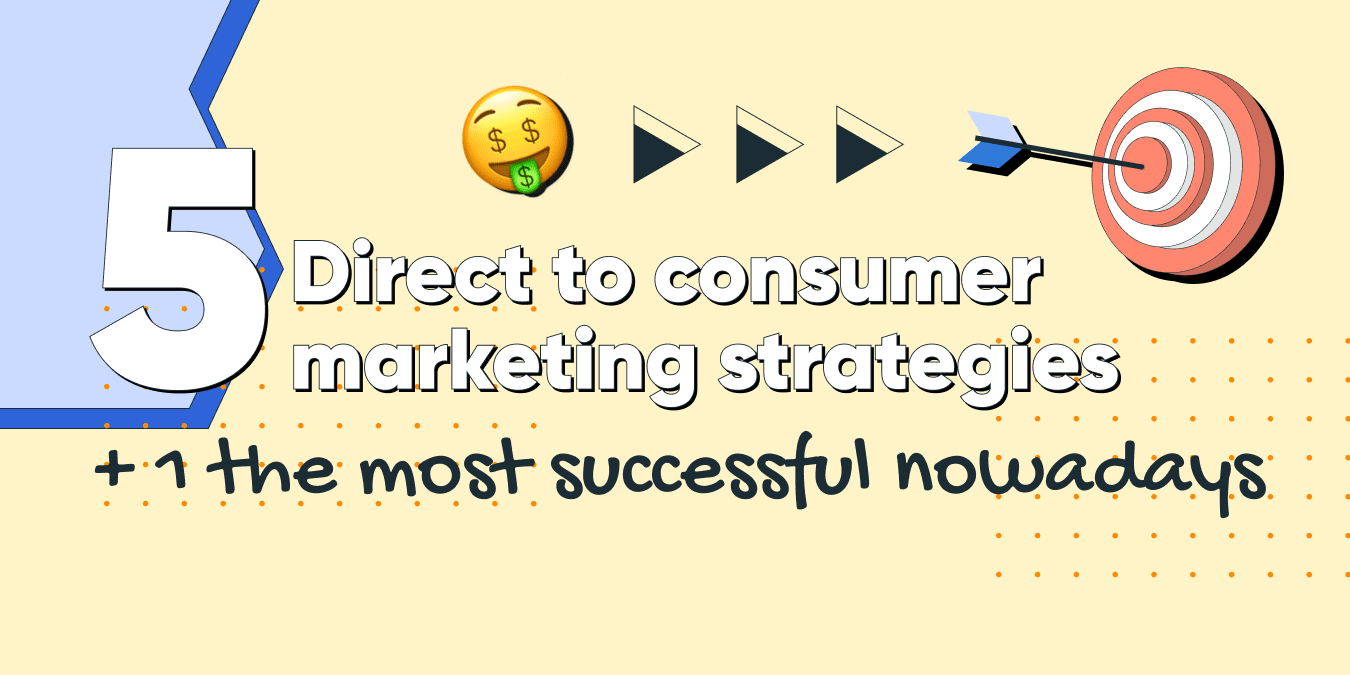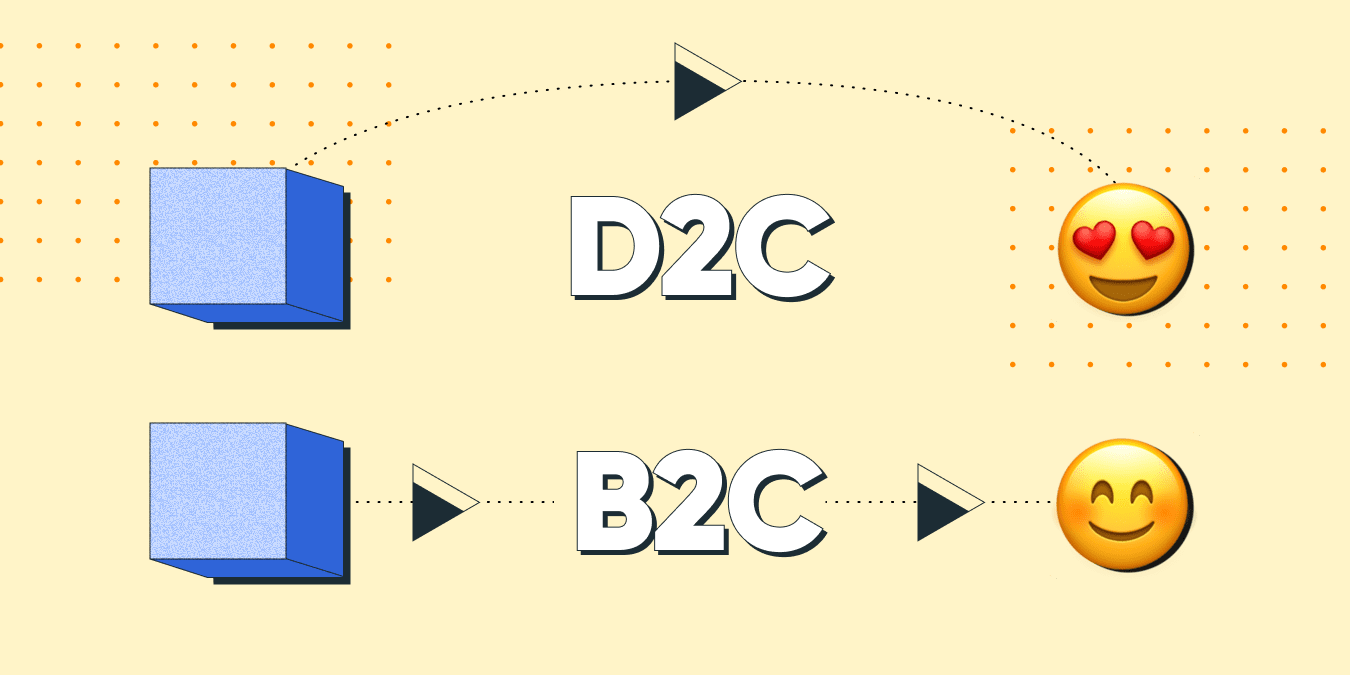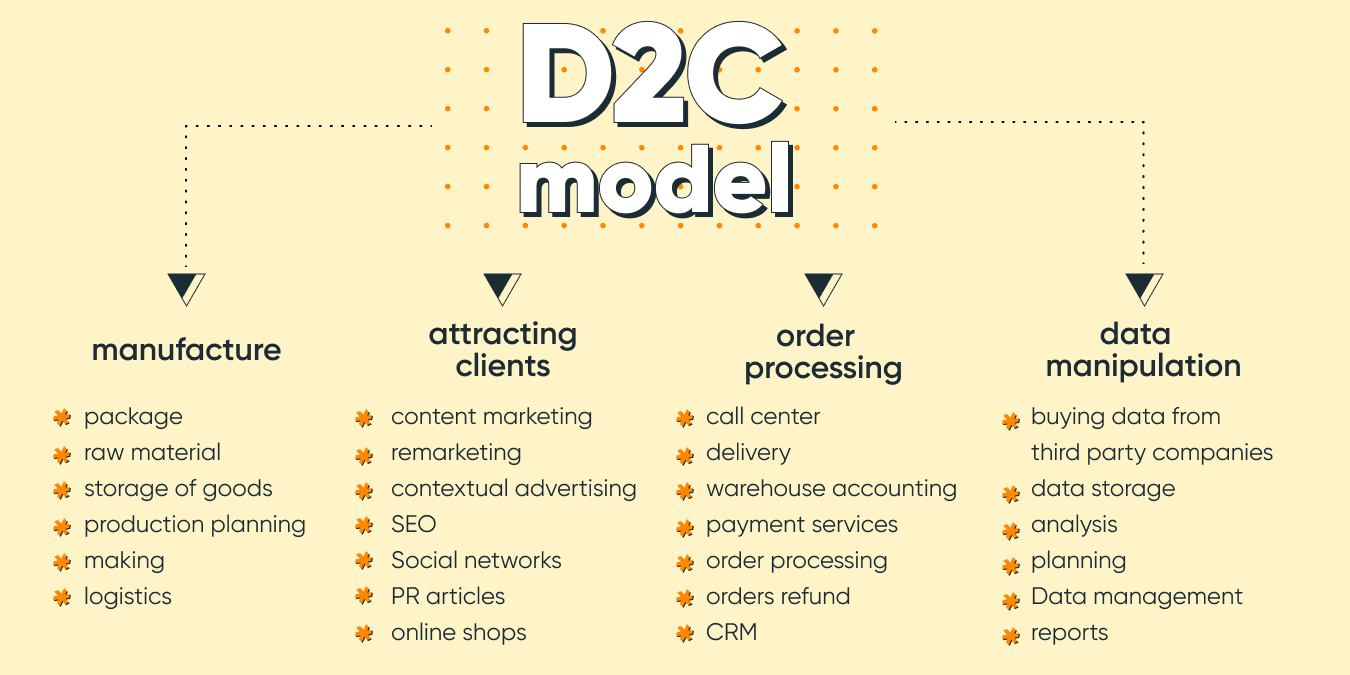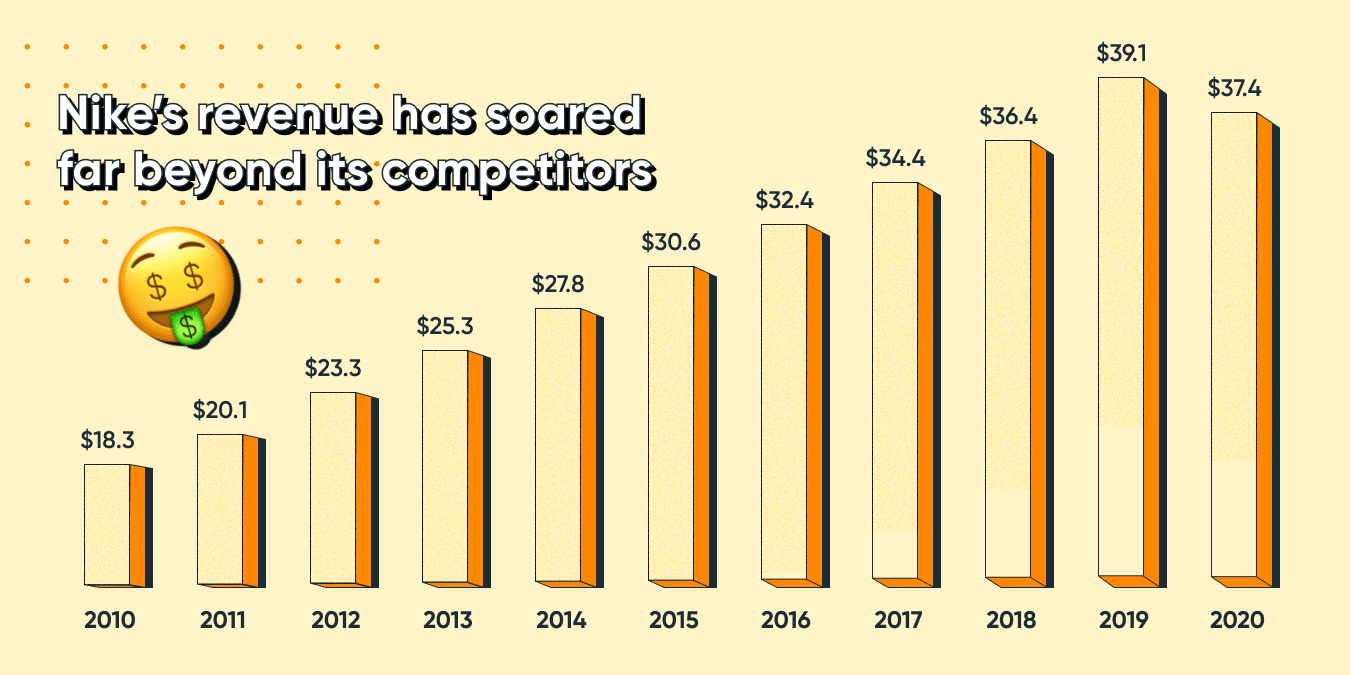
What is DTC marketing? Direct to consumer brands and companies. D2c vs b2c. DTC on Amazon and other marketplace
Let’s discuss D2C, also known as direct to consumer marketing strategy, in terms of selling through marketplaces such as Amazon and Ebay. Those who have even a small idea about this concept may object, because selling through marketplaces is not D2C but B2C. What can I say… do not jump to conclusions.
Nowadays after COVID-19 pandemic started, the line between these concepts has blurred. Looking ahead to say – the use of sales strategies on marketplaces gives undeniable advantages to D2C companies over their competitors. Moreover, we are here to offer you a tool for automating sales at large marketplaces through the ability to manage orders, stocks and price lists in one place. See more about how it works:
Now let’s go back to DTC marketing…
DTC marketing meaning and short history
Direct to consumer, as you can understand from the abbreviation, is the sale of products / services directly to the buyer bypassing any intermediaries. If you look at B2C, there are 1 or n number of retailers, and the items get to the buyer through them.
We will talk about the CONs and PROs later, but for now we want to note that any manufacturer or owner of its own brand can use the DTC format.
Years ago, the DTC marketing definition could be heard only in pharmaceutical and financial structures. Nowadays, the situation has changed considerably.
The direct to consumer marketing strategy first appeared in 2010. Warby Parker, online store selling glasses and sunglasses, used the direct to consumer strategy for the first time. They directed their products not to retailers but directly to consumers. Did it work for them? Yep, and how! Their income in 2019 became $250,000. They have been selling through their online store and offline stores in the U.S. and Canada. This is an excellent example of direct to consumer brands. You understand now what dtc brands meaning?
In fact, I was not quite correct about the date of the first appearance of D2C business. This model was known even before electricity and transportation was invented. But back then it wasn’t as common as it is now. Long distances from the factories to the cities, instead of cars were horses… you know. The first more or less serious sellers in this field can be considered farmers who found their own customers and worked for their own pleasure on a small scale.
D2C vs B2C
We already discussed the first and second types of marketing in the previous chapter. So, to summarize:
DTC marketing is a model of mutual cooperation between a brand/company and the end consumer.
This strategy is more famous as direct sales. These days, this model is a trend and it is gaining more and more popularity year by year. It looks something like this:
B2C is the model of mutual cooperation between the brand/company and the final consumer through a retailer.
BTC is considered to be the traditional type of sales. If you these two types of marketing, they will look something like this:
Let’s try to understand why D2C strategy is becoming so popular.
PROs of D2C:
- Maximum control over the process. Naturally, D2C brands and companies have a direct relationship with their customers. They can receive feedback as quickly as possible, manage product reputation, make improvements and so on.
- The most accurate approach to the consumer. Any link in the chain of people distorts the original information in one way or another. Consumer’s feedback will not be as clear in the B2C strategy as in D2C. DTC brands can get feedback directly, and properly handling it can remove all the shortcomings of the product.
- It is easy to collect feedback. Have you ever tried to collect feedback about a product through a retailer? It’s a very difficult process mainly because of the reseller’s lack of interest in it. When you sell directly to the customer, you can get feedback on an intuitive level, even without knowing any high-tech tools.
The main difference between dtc and b2c is more autonomy.
For some companies this is the crucial factor. When you have that kind of autonomy in your pocket, you can really take your mark to impressive heights.
However, don’t assume that in the D2C vs B2C race, the first model is ahead of the rest of the planet. As with everything, direct selling has its drawbacks which is why not many people choose it.
CONs of D2C:
- Setting up the sales chain. Direct-to-consumer sales is a term that sounds very simple, but in reality some find it difficult to promote their products using this strategy. All of these difficulties can be avoided, but more on that later…
- You have to be an expert in brand advertising. This flaw is similar to the previous one, but still… “You can create a great product, but convincing that it’s great is more important.” These are the words of the marketer in the movie ‘Jobs: Empire of Temptation’.
- Increased costs. If you want to get the most accurate customer feedback and respond effectively, you have to pay more. Allocate a budget for test products, hire the best designers using an effective hiring platform to create a customized brand persona, etc.
Both strategies have their own advantages and disadvantages but… for those who want to be a leader, not mediocrity, for those who want to achieve maximum results, but not to collect breadcrumbs from the monopolists, we recommend you to choose direct selling. Yes, it’s difficult, but who says it will be easy?
Take, for example, the brand Quill, which sells stationery. It’s the best example of a D2C that competes with Amazon and Walmart. Can you feel the level?In this article we will not go into details on creating a mark/company on the DTC model. The product that we can offer is suitable for existing DTC companies and those who have chosen the strategy of multi-channel sales on marketplaces. If you are one of those, we offer you to get acquainted with tariff plans:
5 best DTC marketing examples – brands and companies
Enough theory and scary terms, let’s look at 5 impressive examples of DTC marketing:
- Warby Parker.
- Dollar Shave Club.
- Allbird.
- Nike.
- Acer.
Warby Parker. As we already know, Warby Parker started the modern direct selling. Many B2C businesses don’t like this mark, simply because it disrupted the traditional sales model.
At that time, more than 80% of high-end glasses sales were controlled by – Luxottica. Because of the so-called horizontal supply chain, glasses were too expensive, in particular because of licensing fees. The advantage of this chain is that everyone is in fear and depends on each other except for the main, Luxottica. Because of this huge structure, the glasses were quite expensive, and the middlemen had to reduce the price drastically in order to sell them.
After having analyzed all of this, Warby Parker came to the vertical strategy where everything belongs to one company, for example – raw materials, warehouses. All outsourcing activities were eliminated.
You say this is a huge expense and risk, and it really is, but Warby Parker removed the most unnecessary component, in his opinion,retail stores. He made a very convenient online storefront. The customer could choose various frames, order a free fitting and use the glasses for 30 days free. After suffering such expenses Warby Parker started to gain popularity, and the business quickly took a fat piece of the market from the monopolist Luxottica.
Dollar Shave Club. Could you compete with Gillette? A company that Warren Buffett himself invested in.
One unemployed marketer at the time, Michael Dubin, was able to. He analyzed the market and realized Gillette’s three main problems – the high price, the horizontal sales chain, which increases the price, and the complexity of the razor concept itself.
The commercial that was made for the 2012 Dollar Shave Club was a masterpiece. In just two days they received 12,000 orders… so far the views have exceeded 27 million, can you imagine how many orders that is?
Really, why do you need a razor with a flashlight, back scratcher and 10 blades? It’s just a razor! Grandpa used to shave with one blade, and he had polio…
Michael Dubin simplified the razor concept without sacrificing quality. He created a unique marketing approach. And, most importantly, he chose the D2C – he addressed directly to consumers, made an autonomous manufacturing process, removed all unnecessary details and voila – competitor Gillette, moreover, in the U.S. market – №1. And what shaver do you use?
Allbirds. This company was founded in 2016. Despite such a short existence, Allbirds already boasts more than 200 million in revenues for 2020. You probably wear sneakers or clothes from Allbirds, because they are environmentally friendly. This is an example how the money saved by the absence of intermediaries went directly into the quality of the product.
Before the Allbirds founding, it was believed that such material as nylon is classic. It is cheap, durable, hardwearing but it is not natural, and its production is harmful. All attempts to make shoes and clothing from environmentally friendly materials ended in failure, because the price went up drastically in the B2C.
The founder Tim Brown made a market analysis and chose the D2C. As we can see, the result is great. Premium quality and environmentally friendly materials are used in relatively inexpensive sneakers/wear. They are as durable as nylon.
Nike. Everyone knows the company with an interesting history, but we would like to pay attention to the period from 2011 to 2020. In 2011 Nike launched direct selling. After a year of direct sales this segment accounted for 16% of the company’s total profits. In 2020, it was already 35%. In the next few years, Nike was going to reach a level where direct sales account for most of the company’s profits. The strategy of this company shows the importance of this segment and tremendous prospects for the brand, and it is not about the money, it is about the quality.
I’d like to focus on the 2017 to 2019 period when. Nike began a pilot program of direct to consumer Amazon. Nike acted as a retailer.
As announced by Retaildetail, Nike has ended its pilot sales program on Amazon DTC in 2019 and will focus on more direct sales. The main reason for this is to prevent the sale of counterfeit products on Amazon. We would like to note that the cooperation on the DTC marketplace Amazon has brought Nike several billion dollars.
The company decided not to chase after profits and focus on improving the credibility of the mark. This is the right approach!
We cite this example only to show that direct sales via Marketplace is very profitable. Of course, we are by no means giving advice to Nike. We just want to show you that if you are not a Nike or super hyped brand, the strategy of selling on marketplaces – is one of the best strategies, at least at еру moment when your profits will exceed $2 billion.
Acer. This company is a good example of direct sales through such a marketplace as eBay. Until 2018, this marketplace was considered not at all oriented towards direct sales. However, now the situation has changed. Remember the story with the concept of DTC, which 10 years ago was not widespread, and now it is very much displacing the B2C segment.
Acer was one of the first to start selling directly through eBay. One can argue for a long time about the Amazon vs Ebay battle and the fact that this marketplace is not really suitable for our topic, because local customers are not hunting there for new products. Also, we can’t cite any staggering results on Acer’s profit growth in this area right now. But give Acer a couple more years. We’re betting the effect will be as good as Amazon, so seize the moment.
According to Bob Koopbens, vice president of seller and marketplace operations at eBay, the company is evolving its platform to be the best place for brands.
DTС marketing strategies
We have presented examples of successful DTC companies and brands. From them, you can probably conclude how they operate. If not, let’s summarize and expand on the strategies.
We highlight 4 strategies and 1 tactic that 80% of successful DTС companies use:
- Brand personality.
- Social media communication.
- Opinion from celebrities.
- Customer experience.
- Selling on marketplaces – Amazon and Ebay.
Brand personality. Do you remember the example of Dollar Shave Club? About those Fking Great Blade.
The razor concept was reinvented and through such a spectacular commercial, the concept was remembered. The brand was remembered.
Allbirds began to make environmentally friendly sneakers and shoes at the same time at an affordable price.
If you take Nike in general, it has a staggering history of development. The essence of the identity of the brand is to distinguish it from others. If you want to successfully sell directly to customers, you need something to catch the eye.
By creating a mediocre product, the DTC will not be effective. Use examples, analyze your niche, find buyers’ pain points and create something that isn’t already there. If you think everything is already invented, revisit the examples above.
Communication in social networks. It’s not a secret that social media is a very powerful marketing tool. Communicate with your consumers through social networks, so you will understand the main problems of your company and you can quickly fix them.
You can also share visually engaging flyers made with DesignWiz to enhance your brand presence and drive more interaction.
Opinion of famous faces. If we’re talking about DTC marketing, you have to forget about advertising in its traditional sense. Conventional advertising is good for other types of business. For this concept you need more than that. Think back to that razor commercial again. Does that sound like conventional advertising? If you can’t think of anything like that, it’s important to have famous faces talking about your products and brand.
And it doesn’t have to be in the form of a commercial where you pay a huge amount of money to mention your brand. If you are confident in your products suggest that they should be tested by a celebrity or a blogger. And give your opinion. If the “tester” will be satisfied, he himself will advertise this product… may be for free…
Customer Experience. Offer to test your products to ordinary people to hear and see opinions. This is one of the best tactics today, exactly the tactics that allow you to work effectively on the quality of your products.
To refine products before scaling, many D2C brands also rely on structured consumer testing to understand how real users interact with their offerings. Platforms like Peekage help gather quick, targeted feedback that complements insights from real product usage and testing sessions. This allows brands to validate product decisions early and improve overall customer experience.
Successful DTC brands like Allbirds and Warby Parker also invest heavily in improving user experience through localized websites and personalized content for different markets. To achieve similar results, businesses can benefit from using professional localization partners such as Milengo’s website translation and localization services, ensuring consistent brand messaging across all regions.
Selling on Marketplaces. As we already know, in the DTC type there are no middlemen, there is the manufacturer and there is the end buyer. But as already noted, for the time being retailers in the form of marketplaces can be part of the general model. It’s not about selling to retailers on these marketplaces, it’s about selling on behalf of the company/brand.
If you have recently created a DTC company, then the marketplaces would be just the perfect strategy. If you want to multiply your profits from direct sales, then the marketplace will be a great addition.
Conclusions
We hope you’ve got what DTC marketing is. In the fight against the B2C strategy, in our opinion, DTC wins. Of course, this model is more complex and risky, but the game is worth the risk.
Nowadays more and more people are increasing the segment of direct sales, and some are even completely moving into it.
Creating a DTC brand is quite a complicated task – you need to do a deep analysis of the market. However, in any area you can see seemingly well-established things differently. We have given examples that prove it.
Sellbery focuses on direct sales through marketplaces. This gives you a distinct advantage and a good impetus to the development of the brand. We, in our turn, can provide the product which will help you automate sales from all channels. Moreover, Sellbery product will help you to be in the top search marketplace via SEO algorithm. And this is another strategy, which will save you time and money and help you focus on the authority of your brand.
And what if you have several brands and websites? These sites might be on different platforms, for example WooCommerce or DTC Shopify. In addition, you also want to sell on Amazon, and maybe on Ebay, too?
Was this news helpful?











 Yes, great stuff!
Yes, great stuff! I’m not sure
I’m not sure No, doesn’t relate
No, doesn’t relate



